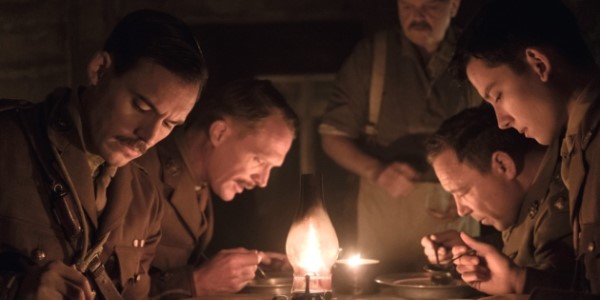We don’t get films set in the First World War nearly as often as WW2, and when we do, we get the fifth adaptation of the same story. Such is the case with Saul’s Dibb’s new cinematic version of R.C. Sherriff’s play Journey’s End, which comes 30 years after the last film version and exactly a century after the war.
“What does it matter? We were all sent here to die”
A fifth adaptation is no negative in this scenario though, for Dibb’s take on the narrative, which follows a cluster of soldiers, in the trenches of Aisne, in the days leading up to the Spring Offensive, is a substantial one. It may be the edition that’s the furthest away in time from the actual events, yet it is arguably the most immersive. Dibb applies a gritty realism to this one, beginning with a murky aesthetic that’s both accurate of the view from the muddy trenches and reflective of the doom and gloom that the troops cope with in the zone.
There’s none of the manufactured mushiness that sometimes plagues war films. Dibb’s unsentimental approach is far more genuine. Nor is there much violence – thought the sporadic moments of it are gruesomely realistic – because it’s instead traded for a close-up dissection of the distinctive personalities involved and the emotional weight behind sending any of them out of the trenches.

We come to understand the mental state of these servicemen through their day-to-day interactions in the trenches: the manner in which they speak with one another, the occasional dispelling of private feelings, even the sort of food they like. As the days go on, the everyday interactions appear to be the customary norms of the division, until their ill-adjusted captain Stanhope (Sam Claflin) lashes out at everyone, pointing out his observations and criticising them for their daily rituals.
Award-worthy acting
If you saw Journey’s End without knowing any of the pre-production details, you might scoff at the original casting choices: Benedict Cumberbatch and Tom Hiddleston. Nothing against the two titan thespians (they’re the go-to Brits for their talents as well as star power) but watching Sam Claflin and Paul Bettany in action makes it impossible to believe that anyone else was considered for their roles.
As Captain Stanhope and the benevolent Lieutenant Osborne, Claflin and Bettany are nothing short of brilliant. At opposite ends of the emotional spectrum, Osborne is able to withstand the horrors whilst Stanhope is outwardly disturbed, the two actors enhance the immersion of the piece with their lived-in performances.
Alongside them is an excellent Asa Butterfield, as the new recruit Raleigh. Raleigh’s excited to be fighting alongside the famed Captain Stanhope. He is taken on perhaps the most plaintive journey of them all and Butterfield is diligent in portraying the harrowing plight that so many young Britains were in.
Raleigh’s story takes place in the Spring of 1918. Today, 100 years later, young Britains aren’t at the frontlines of a world war. Instead, they’re afforded the opportunity to watch the stories of those who were brave enough to ensure that their descendants were given such a chance. Journey’s End is a respectful and important reminder of those who served.
Journey’s End: Conclusion
Powered by memorable performances and Dibb’s sobering deconstruction of the individuals who fought for their country, the engrossing Journey’s End is a hard-nosed, hard-hitting centennial tribute to Britain’s heroes.
What did you think of Journey’s End? Let us know in the comments below!
Journey’s End was released in the UK on February 2, 2018 and will be released in the US on March 16, 2018. For all international release dates, see here.
Does content like this matter to you?
Become a Member and support film journalism. Unlock access to all of Film Inquiry`s great articles. Join a community of like-minded readers who are passionate about cinema - get access to our private members Network, give back to independent filmmakers, and more.